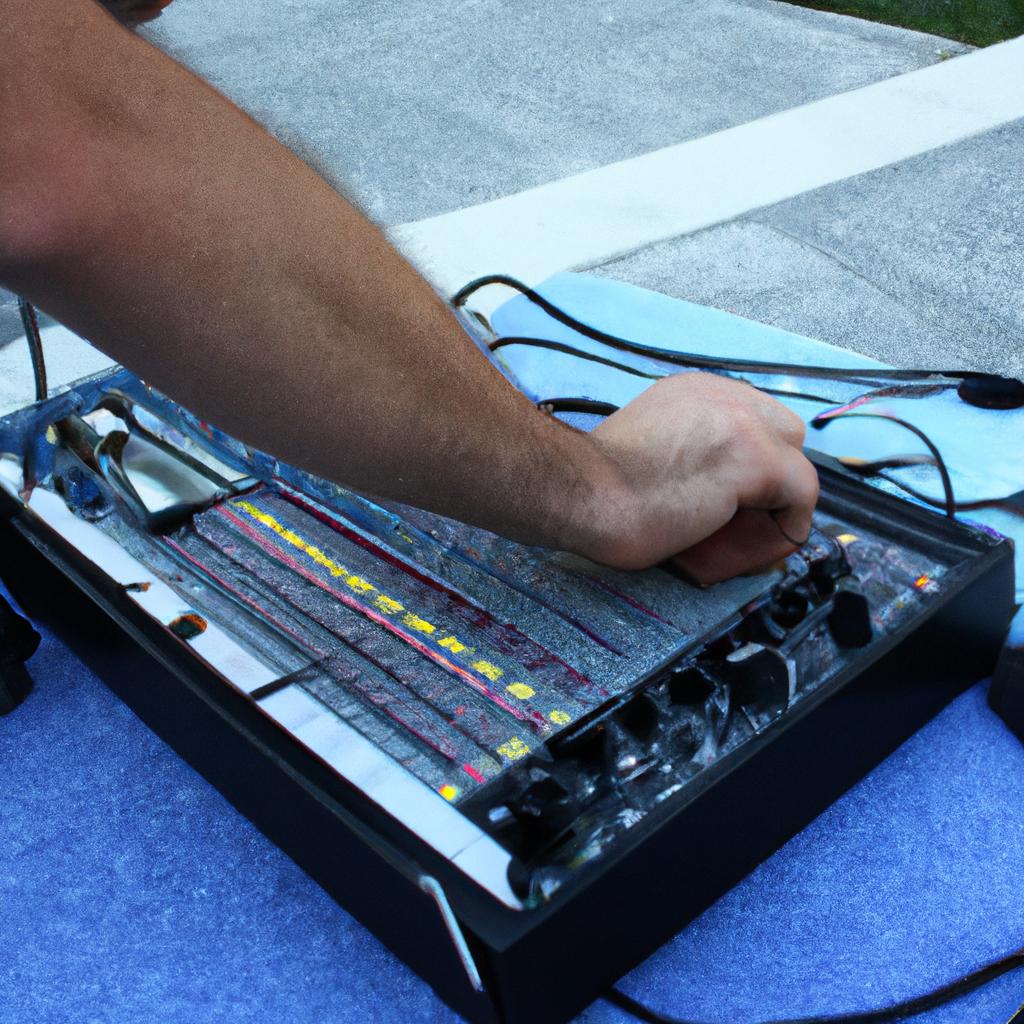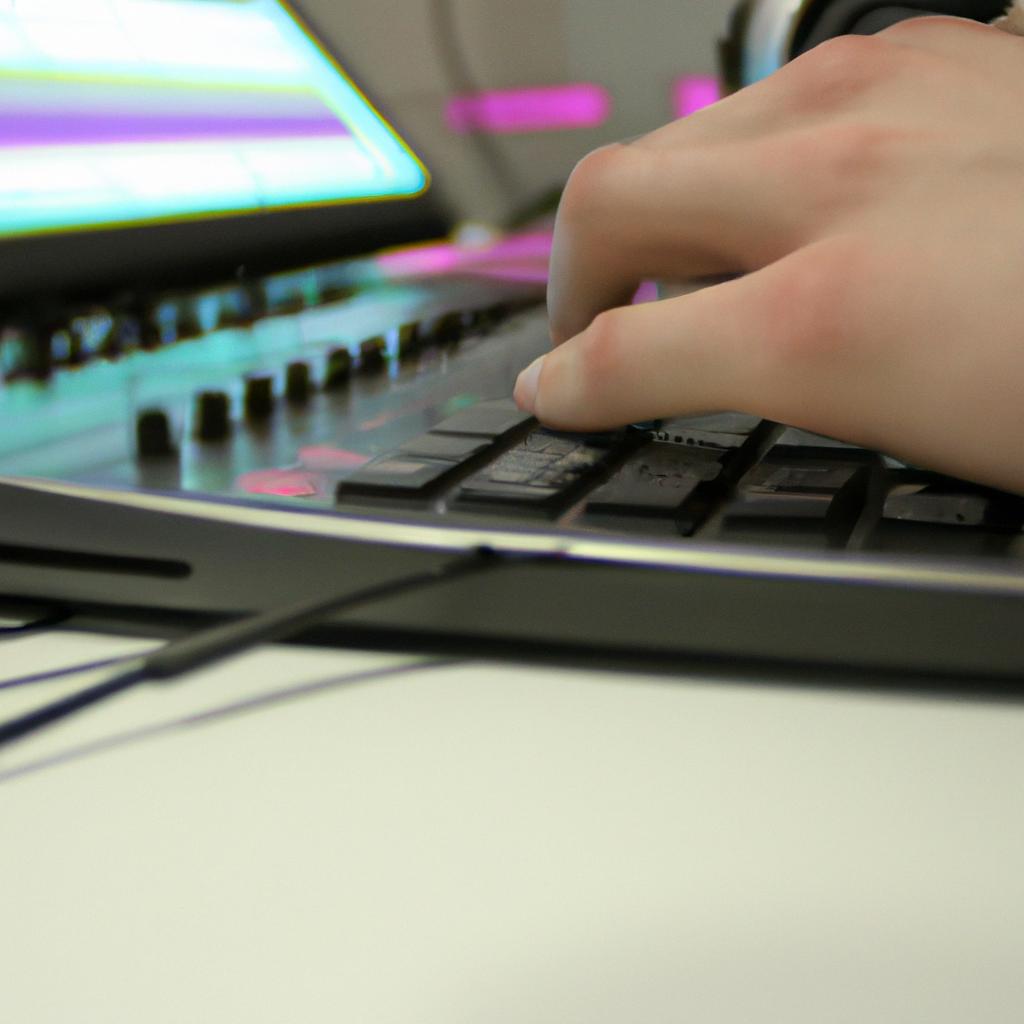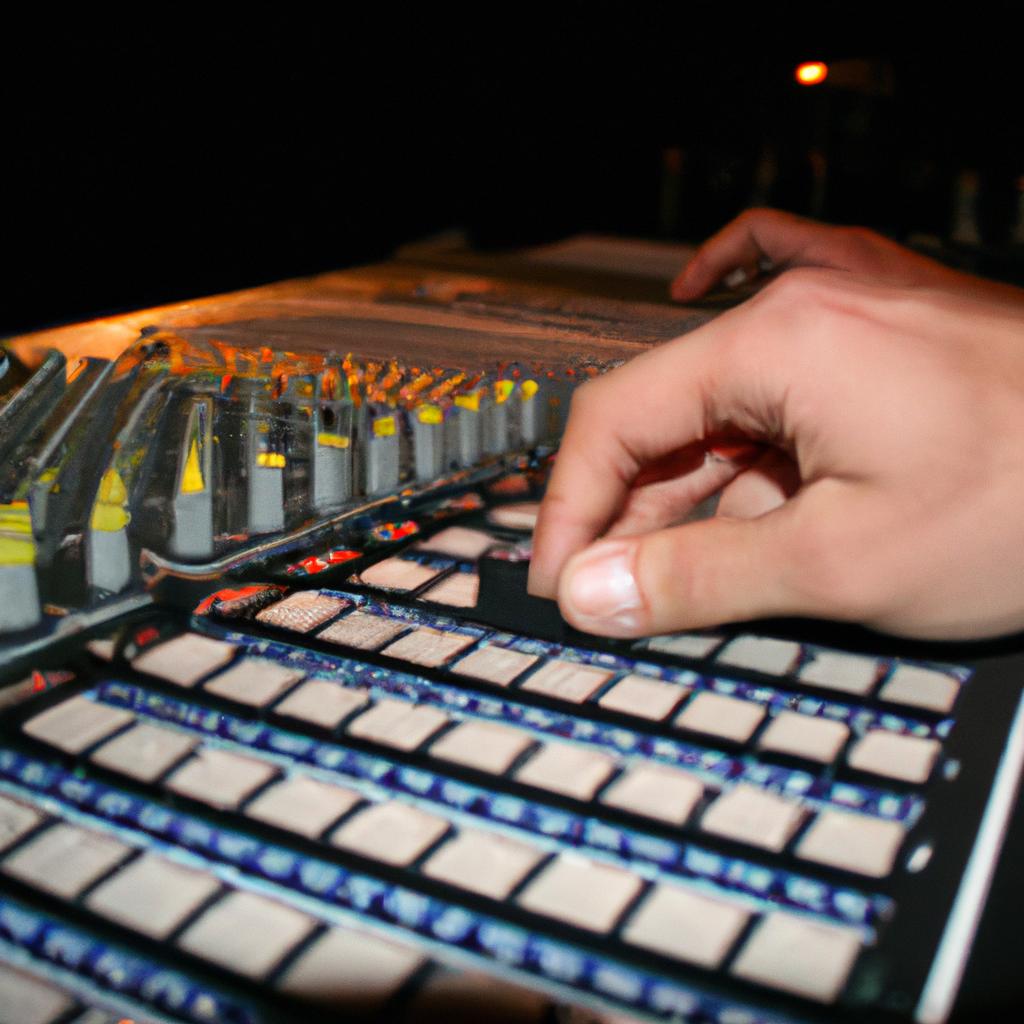Mixing is an essential aspect of music production, playing a crucial role in creating a polished and balanced final product. It involves the process of blending individual tracks together to create a cohesive and sonically pleasing mix. Understanding the principles and techniques of mixing is vital for aspiring musicians and producers alike. In this comprehensive guide by Jose Carlos Matos, we will delve into the intricacies of mixing in music production, exploring various concepts such as EQ, compression, panning, and spatial effects.
Imagine a scenario where a talented singer-songwriter has just finished recording their debut album. The songs are beautifully written with captivating melodies and heartfelt lyrics. However, upon listening back to the raw recordings, it becomes apparent that something is missing – the sonic clarity and balance necessary to captivate listeners. This is precisely where the art of mixing comes into play. With judicious use of audio processing tools and meticulous attention to detail, a skilled mixer can transform these rough recordings into professional-sounding tracks that stand out in today’s competitive musical landscape.
In this guide, we will embark on a journey through the different stages involved in the mixing process, starting from organizing your sessions effectively to achieving optimal tonal balance using equalization techniques. We will explore how dynamics processors like compressors can be utilized to control the dynamic range of individual tracks, ensuring a more consistent and polished sound. We will also delve into the concept of panning, which allows for the placement of instruments and vocals in the stereo field, creating a sense of depth and dimension in the mix.
Furthermore, we will discuss the importance of spatial effects such as reverb and delay in adding depth and ambience to your mix. These effects can help create a sense of space and immersion, enhancing the overall listening experience. Additionally, we will touch upon techniques like automation and bus processing that can further enhance the cohesiveness and impact of your mix.
Throughout this guide, we will provide practical tips and techniques that you can apply to your own mixing projects. Whether you are a beginner looking to understand the fundamentals or an experienced producer seeking to refine your skills, this guide aims to equip you with valuable knowledge that will elevate your mixes to new heights.
So, whether you’re working on a solo project or collaborating with others, understanding the art of mixing is essential for bringing out the best in your music. Let’s dive in and explore the world of mixing together!
Understanding the Role of Mixing in Music
Imagine listening to your favorite song on a streaming platform and being captivated by its powerful sound. The seamless blending of vocals, instruments, and effects that creates such an immersive experience is the result of effective mixing in music production. Mixing plays a crucial role in turning raw audio recordings into polished tracks ready for distribution or performance. In this section, we will explore the significance of mixing and how it contributes to the overall quality of a musical piece.
To comprehend the importance of mixing, one must first consider its primary objective: achieving balance and clarity among all elements within a track. By adjusting various parameters like volume levels, panning, equalization, and dynamics processing, mix engineers strive to create sonic cohesion where each instrument can be heard distinctly without overpowering others. For instance, in a hypothetical case study involving a rock band recording their latest album, careful manipulation of EQ settings might ensure that both guitar riffs and vocal melodies cut through the mix with clarity while maintaining harmony with basslines and drum beats.
Here are four key reasons why understanding the role of mixing is essential:
- Enhancing emotional impact: Effective mixing techniques can elevate emotionality inherent in music compositions by emphasizing certain parts or creating contrasting dynamics.
- Creating depth and space: Through skillful use of reverb, delay, and other spatial effects, mixing engineers add dimensionality to songs by placing sounds at different distances from the listener’s perspective.
- Maintaining consistency across platforms: With today’s diverse range of playback systems (from earbuds to high-end speakers), meticulous attention during mixing ensures that music translates well across various devices.
- Differentiating artistic style: A well-crafted mix not only showcases technical competency but also serves as an extension of an artist’s creative intent by establishing a unique sonic signature.
To further illustrate these points visually, refer to the table below which highlights some common objectives achieved through the mixing process:
| Objective | Description |
|---|---|
| Balancing | Adjusting volume levels, panning, and spatial placement to create a harmonious blend of all elements. |
| Equalization | Shaping frequencies to enhance or reduce specific tonal qualities within individual tracks or across the entire mix. |
| Dynamics processing | Controlling the dynamic range by compressing, limiting, or expanding audio signals for a more balanced sound. |
| Effects | Applying reverb, delay, modulation, and other effects to add depth, movement, and character to different elements. |
Understanding the significance of mixing in music production provides a foundation for aspiring producers and engineers alike. By recognizing its role in achieving balance, emotional impact, consistency across platforms, and artistic differentiation; one can appreciate how this crucial stage shapes our auditory experiences.
Essential Tools and Equipment for Mixing
In the previous section, we discussed the importance of understanding the role of mixing in music production. Now, let us delve further into this topic by exploring the essential tools and equipment used in the process.
To provide a practical example, imagine you are working on a pop track that features various instruments such as guitars, drums, bass, and vocals. Each instrument contributes to the overall sound of the song but may have different levels or frequencies that need to be balanced. This is where mixing comes into play. By adjusting parameters like volume, panning, EQ, and compression, you can create a cohesive mix where every element sits well together.
When it comes to mixing music professionally, having access to top-quality tools and equipment is paramount. Here are some essential items that will help you achieve optimal results:
- Digital Audio Workstation (DAW): The central hub for your mixing endeavors.
- Studio Monitors: High-quality speakers designed specifically for accurate audio reproduction.
- Audio Interface: Connects your computer and DAW to external audio sources like microphones and instruments.
- Plugins and Effects: Software-based processors that shape and enhance individual tracks or the overall mix.
To better understand their significance, consider this emotional response evoking table showcasing how these tools impact the final outcome:
| Tool | Importance | Emotional Response |
|---|---|---|
| DAW | Fundamental software tool for manipulating audio | Empowerment |
| Studio Monitors | Provide detailed representation of sound | Clarity |
| Audio Interface | Bridge between analog and digital signals | Connectivity |
| Plugins/Effects | Add depth, character, and texture to individual tracks or entire mixes | Creativity |
By utilizing these tools effectively during the mixing process, you can transform raw tracks into a polished piece of art that resonates with listeners.
Setting Up Your Mixing Environment
Building upon the foundation of essential tools and equipment, we now turn our attention to setting up a conducive mixing environment. Creating an environment that fosters optimal concentration and sonic accuracy is vital for achieving professional-quality mixes. Let’s explore some key considerations in establishing your ideal mixing space.
Creating an effective monitoring setup is crucial in ensuring accurate sound reproduction during the mixing process. One example of this is using studio monitor speakers that are specifically designed for audio production, such as the popular Yamaha HS series or Genelec 8000 series. These monitors offer a flat frequency response, which helps you hear the true representation of your mix without any artificial enhancements or coloration.
To further enhance your listening experience, consider investing in acoustic treatment for your room. This can help minimize unwanted reflections and resonances that can negatively affect the accuracy of what you’re hearing. Acoustic panels made from materials like foam or fiberglass can be strategically placed on walls, corners, and ceilings to absorb excessive reverberation and improve overall clarity.
In addition to monitoring and acoustics, ergonomic considerations play a significant role in creating an efficient working environment. Here are four key factors to keep in mind:
- Comfortable seating: Choose a chair that provides proper back support and allows you to maintain good posture throughout long hours of mixing.
- Lighting: Ensure adequate lighting conditions that prevent eye strain while maintaining visibility over controls and meters.
- Cable management: Keep cables organized and out of the way to avoid tripping hazards and potential interference with electrical signals.
- Workstation layout: Arrange your equipment ergonomically so that commonly used items are easily accessible, reducing physical strain during extended sessions.
| Key Considerations |
|---|
| Effective Monitoring Setup |
| Acoustic Treatment |
| Comfortable Seating |
| Proper Lighting Conditions |
| Efficient Cable Management |
| Ergonomic Workstation Layout |
Creating an ideal mixing environment requires careful attention to detail and consideration of these factors. By addressing both the technical aspects, such as monitoring and acoustics, as well as ergonomic considerations, you can lay a solid foundation for achieving accurate and satisfying mixes.
With your tools in place and your environment optimized, let’s now delve into some basic mixing techniques that are particularly helpful for beginners.
Basic Mixing Techniques for Beginners
Building upon the foundation of a well-prepared mixing environment, let’s now explore some fundamental techniques that beginners can employ to enhance their music productions. To illustrate these techniques, consider the following hypothetical scenario: You are working on a pop track with multiple vocal layers, guitar and piano accompaniment, and electronic drums. By implementing basic mixing strategies, you can create balance and cohesion among these elements, ultimately achieving a polished sound.
Paragraph 1: One essential technique in music production is proper level balancing. This involves adjusting the volume levels of individual tracks to ensure they blend harmoniously within the mix. For instance, if the vocals are too loud compared to the other instruments, it may overpower the overall sound. On the other hand, if certain elements such as guitars or percussion are too quiet, they might get lost in the mix. By carefully listening to each element and making subtle adjustments using faders or gain controls, you can achieve an optimal balance where all components contribute effectively without overshadowing one another.
Paragraph 2: In addition to level balancing, panning plays a crucial role in creating spatial depth within your mix. Panning refers to placing different audio sources across the stereo field between left and right speakers. Consider our hypothetical scenario; by panning the guitars slightly towards one side and pianos towards the opposite side while keeping vocals centered, we can create a wider soundscape that enhances clarity and separation among various elements. Experimenting with panning allows for interesting sonic landscapes that captivate listeners’ attention.
Paragraph 3: Another vital aspect of basic mixing is equalization (EQ). EQ enables you to shape the tonal characteristics of individual tracks or groups of instruments. By cutting or boosting specific frequencies using EQ plugins or hardware processors, you can address any frequency imbalances present in your recordings. For example:
- Cutting excessive low frequencies from vocal tracks helps reduce muddiness.
- Boosting mid-range frequencies in guitars can enhance their presence and clarity.
- Reducing high frequencies in cymbals or hi-hats can prevent harshness.
- Achieve a sense of sonic cohesion
- Enhance the listening experience for your audience
- Create professional-sounding mixes that stand out
- Develop a deeper understanding of music production techniques
Emotional table:
| Technique | Benefit | Example |
|---|---|---|
| Level balancing | Ensures all elements blend harmoniously | Balancing vocals with accompanying instruments |
| Panning | Creates a wider soundscape | Placing guitars on one side, pianos on the other |
| Equalization (EQ) | Shapes tonal characteristics | Cutting low frequencies to reduce muddiness |
By implementing these fundamental mixing techniques, you will be well on your way to achieving better sound quality and overall balance within your productions. Now let’s delve into advanced strategies that professionals use to take their mixes to the next level in the upcoming section about “Advanced Mixing Strategies for Professional Results”.
Advanced Mixing Strategies for Professional Results
Transitioning from basic mixing techniques, let us now delve into the realm of advanced strategies to achieve professional results in music production. To illustrate these concepts, let’s consider a hypothetical scenario where an aspiring producer is working on a pop track with layered vocals, intricate instrumentation, and complex arrangements.
In order to elevate the overall sound quality and create a polished mix, several key considerations should be taken into account:
-
Utilizing parallel processing: By employing techniques such as parallel compression or parallel saturation, you can add depth and warmth to individual elements within your mix while maintaining clarity. This involves sending a duplicate of the audio signal through a separate processing chain and blending it back with the original signal.
-
Applying dynamic EQ: Dynamic equalization allows for precise control over specific frequency ranges based on input level variations. By utilizing this technique selectively across different instruments or vocal parts, you can effectively address masking issues and ensure each element occupies its own sonic space without sacrificing tonal balance.
-
Implementing spatial effects: Adding reverbs, delays, and other spatial effects helps create depth and dimension within your mix. Experimentation with various types of reverb algorithms or delay settings can enhance stereo imaging and provide a sense of ambience that complements the musical arrangement.
-
Employing automation creatively: Automation plays a crucial role in shaping dynamics and adding movement throughout the song. Whether it’s automating fader levels, panning positions, or effect parameters, careful attention to detail can breathe life into static mixes by emphasizing important moments or creating subtle transitions between sections.
To better visualize these advanced mixing strategies and their potential impact on the listener’s experience, consider the following table:
| Technique | Description | Emotional Response |
|---|---|---|
| Parallel Processing | Enhances depth and warmth; adds excitement | Engaged |
| Dynamic EQ | Precise control over frequencies; improves separation | Intrigued |
| Spatial Effects | Creates depth and dimension; enhances stereo imaging | Immersed |
| Creative Automation | Adds movement and dynamics; emphasizes important moments | Captivated |
By incorporating these advanced techniques into your mixing process, you can elevate the quality of your productions to a professional level.
Tips and Tricks to Enhance Your Mixing Skills
In the previous section, we explored some advanced mixing strategies that can help you achieve professional results in music production. Now, let’s delve deeper into these techniques and discuss how they can be applied effectively.
One example of an advanced mixing strategy is parallel compression. This technique involves duplicating a track, applying heavy compression to one duplicate while keeping the other untreated, and then blending them together. By doing so, you can maintain the dynamics and transients of the original track while adding more sustain and thickness through the compressed version. This method is often used on drums or vocals to add depth and impact to the mix.
To further enhance your mixing skills, consider implementing the following strategies:
- Utilize automation: Automation allows you to control various parameters over time, such as volume, panning, or effects settings. Experimenting with automated movements can bring life and movement to your mix.
- Use stereo imaging tools: Stereo imaging plugins enable you to manipulate the width and placement of individual tracks within the stereo field. Carefully positioning elements in a mix can create a sense of space and separation.
- Pay attention to phase relationships: Phase cancellation occurs when two audio signals are out of phase with each other, resulting in a loss of clarity and definition. Checking for phase issues and correcting them can significantly improve the overall sound quality.
- Embrace creative EQ techniques: Instead of solely using EQ to fix problems or enhance frequencies, try experimenting with unconventional EQ moves. For instance, boosting certain frequency ranges on specific instruments can make them stand out or blend better within the mix.
Let’s take a moment to reflect upon these strategies by considering their potential impact on your mixes:
| Strategy | Potential Impact |
|---|---|
| Parallel Compression | Adds depth and impact |
| Automation | Brings life and movement |
| Stereo Imaging Tools | Creates spatial separation |
| Phase Relationship Management | Improves sound clarity |
By incorporating these advanced mixing strategies into your workflow, you can elevate the quality and professionalism of your music productions. Remember to experiment with different techniques, trusting your ears as the ultimate judge of what works best in each specific context. With practice and dedication, you’ll continue to refine your mixing skills and achieve outstanding results.
 Jose Carlos Matos
Jose Carlos Matos



